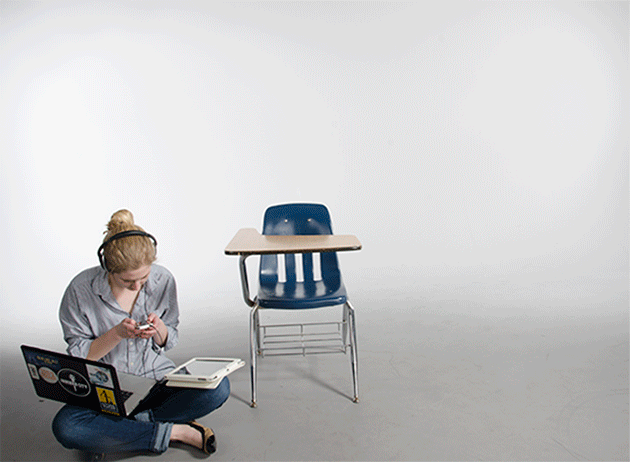At any given time, Bracken Library is full of students hovered over books, using flashcards and wielding highlighters, all studying material to prepare for tests. While it appears many students take some approach to studying, the results of a new research study show that some techniques are more effective than others.
A 2012 study published in Psychological Science in the Public Interest, “Improving Students’ Learning With Effective Learning Techniques” reviewed studies on 10 techniques based on cognitive and educational psychology research and found that some study skills such as highlighting or re-reading are not as effective as they are widely-used.
The researchers found common study techniques like summarizing, highlighting and re-reading were rated as having low utility, less than self-explanation and in-depth questioning. Practice testing and distributing practice sessions over time are the most effective techniques, according to the study..
Kent State associate professor of psychology Katherine Rawson said the team had a good idea as to what the findings would be because of prior research, but the results may surprise students and educators.
“We already knew which strategies were the winners and which ones weren’t,” she said. “The surprise is on the user-end of the strategies. Students regularly report using highlighting and re-reading when the literature suggests they are not particularly effective strategies.”
Kent State professor and director of experimental training John Dunlosky, who worked on the team of researchers with Rawson, said methods like highlighting can be useful, but they cannot stand alone.
“Highlighting is just the beginning,” he said via email. “Students can begin by highlighting the most important information, but then they should review that information from time to time until they have learned it well. And, when students reread, they often do so passively, so they need to use other strategies [such as self testing] as they are reviewing their notes to learn them best.”
Junior telecommunications sales and promotions major Kelsey Granitz has tried to determine what study techniques work best for her. In the fourth grade, she was taught to write information down seven times so she can remember it, which she said the technique has been effective for her, but she wishes she had more information on how to study.
“It is hard to study and if you don’t know what you’re doing, you’re not going to have any results,” Granitz said. “You need to have techniques that can be effective. I’d say I was taught a little bit but it needs to be elaborated on, especially in high school as tests are bigger parts of your grades.”
Ball State assistant professor of psychological science James Rohrer said freshmen come to college with little knowledge of how to study. He attributes the deficiency to 12 years of being taught under the teach-to-the-test mentality.
“Almost all [students] in public school were literally taught to the test because of accountability,” he said. “[Students have not been] learning the information, they’re just learning it to puke it back. We can’t blame [students] because adults who should have known better have set this system up and [students] have learned that’s good education when it’s not.”
Rohrer cited many resources on campus like the learning and writing centers that many students don’t take advantage of, and the most effective studying involves creating different pathways of learning using a combination of different methods.
Alisha Layman, a study strategies tutor for the Learning Center, works with students to help them with time management and how to read their textbooks.
Layman echoed Rohrer’s sentiment that few students know how to effectively study.
“The biggest problem is mostly freshmen come to us [who] have never had to study before in high school and they don’t know how,” she said. “They don’t think they need to take notes in class, they don’t think they need to study for class until the first test comes along and they bomb the test.”
Sophomore computer technology major Daniel Flores picked up a study technique during high school — silly word associations. He changes names or terms to something funny so he can remember it more effectively.
Flores said this method helps him get through tests
“I remember in high school I picked up on some things but I had to teach myself how to study,” he said. “No teacher covers that. You get to college and you didn’t really learn study techniques in high school and you’re generally left in the dark.”
In high school, Flores said he used the cram method but found that it didn’t work with the amount of material on college tests. Like Granitz, he said teaching students how to study would be helpful college preparation.
“I think it would be awesome if there was a class to teach you to do it over a span of time so you could actually learn the material instead of cramming and doing the test and forgetting what you learned,” Flores said.
Throughout her career, Rawson said she has spent a large amount of time focusing on effective study techniques. She doesn’t think all of the research on the subject has translated to actual practice in the classroom, though.
Although she does not think their research findings will immediately change what is practiced, it is work in the right direction.
“No, [people are not using effective study techniques]. There is not a good bridge between empirical based research and practice as to what students do and what teachers do,” Rawson said. “[Our report] is something teachers and students can access. It’s probably one stone in the foundation of a bridge, but there is a lot more bridge that is going to have to be built on top of it.”


